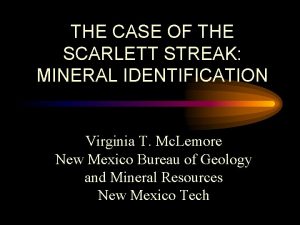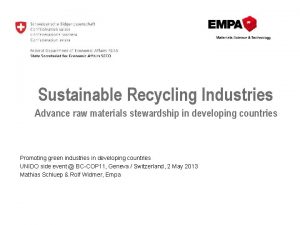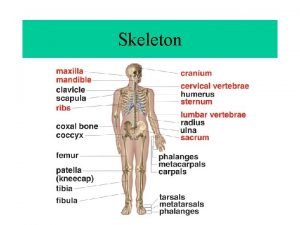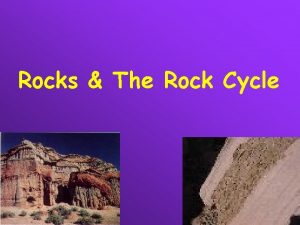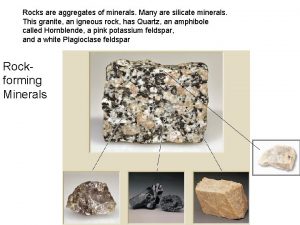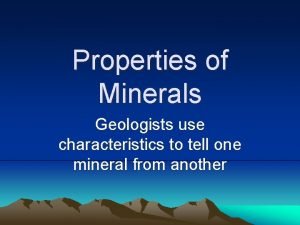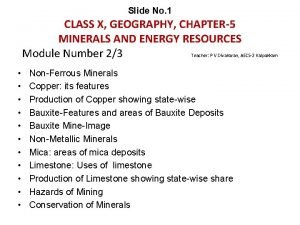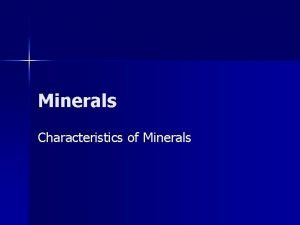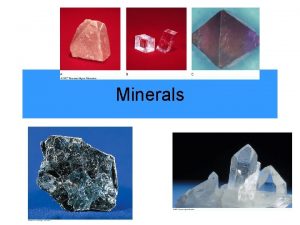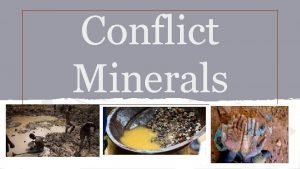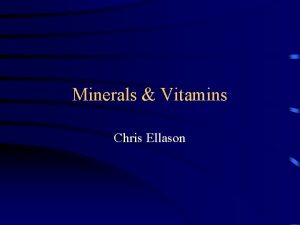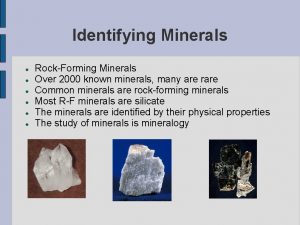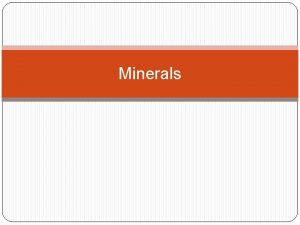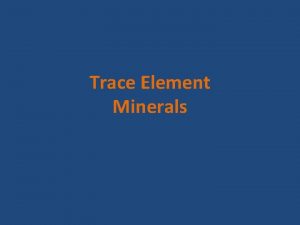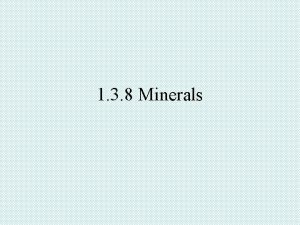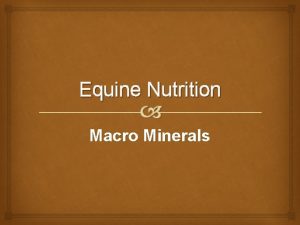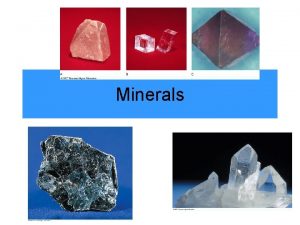Slide No 1 CLASS X GEOGRAPHY CHAPTER5 MINERALS














- Slides: 14

Slide No. 1 CLASS X, GEOGRAPHY, CHAPTER-5 MINERALS AND ENERGY RESOURCES Module Number 1/3 Teacher: P V Divakaran, AECS-2 Kalpakkam Sub topics to be discussed • What is a mineral? • Mode of occurrence of minerals • Distribution of Minerals in India • What is mining? • Who owns minerals? • What is Rat-Hole mining? • Classification of Minerals • Ferrous Minerals • Iron Ore • Iron ore producing areas in India • Production of iron ore showing state wise share • Manganese • Production of Manganese showing state wise share • Recapitulation

Slide No. 2 What is a mineral? • A homogeneous, naturally occurring substance with a definable internal structure is called mineral. • Minerals are found in varied forms in nature, ranging from the hardest diamond to the softest talc. • Why are they so varied? • It is because the formation of minerals depend upon physical and chemical conditions that results in a wide range of colours, hardness, crystal forms, lustre and density of a mineral.

• • Slide No. 3 • o o o MODE OF OCCURRENCE OF MINERALS Minerals are usually found in ‘ores’ What is an ore? An ore is an accumulation of any mineral mixed with other elements. The mineral content of the ore must be in sufficient concentration to make its extraction commercially viable. Minerals generally occur in the following forms: Veins and lodes: In igneous and metamorphic rocks minerals may occur in the cracks, crevices, faults or joints. The smaller occurrences are called veins and the larger are called lodes. Examples are minerals like tin, copper, zinc, lead etc. Beds or layers: In sedimentary rocks a number of minerals occur in beds or layers. They have been formed as a result of deposition, accumulation and concentration in horizontal layers of the rock. Coal, some forms of iron ore, gypsum, potash , sodium salts etc. Decomposition of surface rocks: When the decomposition of surface rocks occurs with the removal of soluble constituents, it leaves a residual mass of weathered material containing mineral ores. Bauxite is formed in this way. Alluvial deposits/ placer deposits : Some minerals are found in sands of valley floors and the base of hills. These deposits are also called as ‘placer deposits’. They are not corroded by water. Examples are: gold, silver, tin and platinum. Ocean waters: The ocean waters contain vast quantities of minerals, but most of these are spread over a wide area. Therefore they are economically not viable. However, common salt, magnesium and bromine are largely derived from ocean waters. The ocean beds, too, are rich in manganese nodules.

Slide No. 4 Distribution of Minerals in India • India is fortunate to have fairly rich and varied mineral resources. However, these are unevenly distributed. • Peninsular Plateau: Peninsular rocks contain most of the reserves of coal, metallic minerals, mica and many other nonmetallic minerals. • Gujarat and Assam: Sedimentary rocks on the western and eastern flanks of the peninsula, in Gujarat and Assam have most of the petroleum deposits. • Rajasthan: It has reserves of many non-ferrous minerals. • Northern Plains: The vast alluvial plains of north India are almost devoid of economic minerals. • These variations exist largely because of the differences in the geological structure, processes and time involved in the formation of minerals.

Slide No. 5 What is mining? • The economic activity of extraction of minerals from below the earth’s surface is called mining. • the concentration of mineral in the ore, the ease of extraction and closeness to the market play an important role in affecting the economic viability of a reserve. Thus, to meet the demand, a choice has to be made between a number of possible options. When this is done a mineral ‘deposit’ or ‘reserve’ turns into a mine.

Slide No. 6 Who owns minerals? What is Rat-Hole mining? • Most of the minerals in India are nationalised and their extraction is possible only after obtaining due permission from the government. • But in most of the tribal areas of the north-east India, minerals are owned by individuals or communities. • Meghalaya, is rich in the deposits of coal, iron ore, limestone and dolomite etc. • Coal mining in Jowai and Cherapunjee is done by family member in the form of a long narrow tunnel, this is known as ‘Rat hole’ mining.

Slide No. 7 Classification of Minerals

Slide No. 8 Ferrous Minerals • Metallic minerals having iron content are called Ferrous Minerals. • These minerals account for about three fourths of the total value of the production of metallic minerals. • They are the strong base for the development of metallurgical industries.

Slide No. 9 Iron Ore • Iron ore is the basic mineral and it is the backbone of industrial development. • India is rich in good quality iron ores. Magnetite: • Magnetite is the finest iron ore with a very high content of iron up to 70%. • It has excellent magnetic qualities. • It is valuable in the electrical industry. Hematite: § It is the most important industrial iron ore in terms of the quantity used. § But it has a slightly lower iron content than magnetite. (50 -60 per cent). Iron ore producing areas in India: 1. Odisha-Jharkhand Belt: High grade hematite ore is found in Badampahar mines of Mayurbhanj and Kendujhar districts of Odisha and Gua and Noamundi mines of Singbhum district of Jharkhand.

Slide No. 10 2. Durg-Bastar-Chandrapur Belt: § § § It lies in Chhattisgarh and Maharashtra. The Bailadila hills of the Bastar district of Chhattisgarh look like the hump of an ox, and hence its name. Super high grade hematite iron ore is found in the Bailadila range of hills. It has the best physical properties needed for steel making. Iron ore from these mines is exported to Japan and South Korea via Vishakhapatnam port. 3. Ballari-Chitradurga-Chikkamagaluru-Tumakuru Belt: • § § This belt in Karnataka has large reserves of iron ore. Kudre in Kannada means horse. The highest peak in the western ghats of Karnataka resembles the face of a horse. The Kudremukh mines located in the Western Ghats of Karnataka are a 100 per cent export unit. The iron ore from Kudremukh is transported as slurry through a pipeline to a port near Mangaluru. 4. Maharashtra-Goa Belt: § § It includes the state of Goa and Ratnagiri district of Maharashtra. The ores from these area are not of very high quality. Still they are very efficiently extracted. Iron ore from here is exported through Marmagao port.

Slide No. 11 Production of iron ore - state wise share in per cent, 2009 -10

Slide No. 12 • • • Manganese is mainly used in the manufacturing of steel and ferro-manganese alloy. For manufacturing one tonne of steel nearly 10 kg of manganese is required. It is also used in manufacturing bleaching powder, insecticides and paints. Production of Manganese showing state wise share in per cent, 2009 -2010

Slide No. 13 Distribution of iron ore and manganese

Slide No. 14 1. What is an ore? Recapitulation 2. What are veins and lodes? 3. What are placer deposits? Give examples. 4. What is Rat-Hole mining? 5. Name the two types of iron ore found in India. 6. What are the uses of manganese? 7. What is a mineral? 8. Which is the best variety of iron ore? 9. Which state is the leading producer of manganese? 10. Give example for hardest and softest minerals.
 Heel and toe heel and toe slide slide slide lyrics
Heel and toe heel and toe slide slide slide lyrics Slide and divide method of factoring
Slide and divide method of factoring Ap human geography frqs
Ap human geography frqs 5 themes of geography ap human geography
5 themes of geography ap human geography Stateless nation
Stateless nation Welcome to your class
Welcome to your class Streak of minerals
Streak of minerals Conflict minerals
Conflict minerals Storage of minerals
Storage of minerals Ravine erosion
Ravine erosion Solid rock cycles
Solid rock cycles Rocks are aggregates of minerals
Rocks are aggregates of minerals Types of rocks
Types of rocks Granite and basalt difference
Granite and basalt difference Cleavage of minerals
Cleavage of minerals






